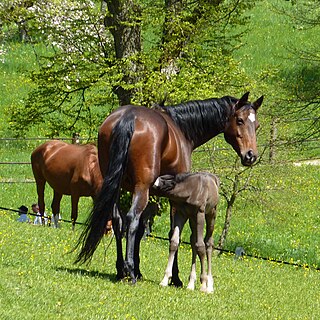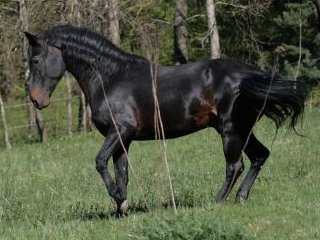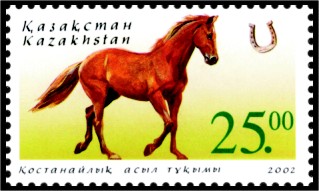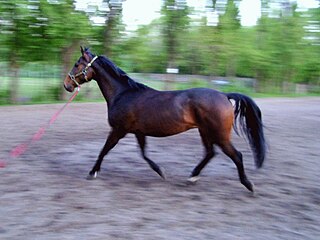
Trakehner is a light warmblood breed of horse, originally developed at the East Prussian state stud farm in the town of Trakehnen from which the breed takes its name. The state stud was established in 1731 and operated until 1944, when the fighting of World War II led to the annexing of East Prussia by Russia, and the town containing the stud renamed as Yasnaya Polyana.

The Arabian or Arab horse is a breed of horse that originated on the Arabian Peninsula. With a distinctive head shape and high tail carriage, the Arabian is one of the most easily recognizable horse breeds in the world. It is also one of the oldest breeds, with archaeological evidence of horses in the West Asia that resemble modern Arabians dating back 4,500 years. Throughout history, Arabian horses have spread around the world by both war and trade, used to improve other breeds by adding speed, refinement, endurance, and strong bone. Today, Arabian bloodlines are found in almost every modern breed of riding horse.

The Cleveland Bay is a breed of horse that originated in England during the 17th century, named after its colouring and the Cleveland district of Yorkshire. It is a well-muscled horse, with legs that are strong but short in relation to the body. The horses are always bay in colour, although a few light hairs in the mane and tail are characteristic of some breed lines. It is the oldest established horse breed in England. The ancestors of the breed were developed during the Middle Ages for use as pack horses, when they gained their nickname of "Chapman Horses". These pack horses were cross-bred with Andalusian and Barb blood, and later with Arabians and Thoroughbreds, to create the Cleveland Bay of today. Over the years, the breed became lighter in frame as they were employed more as carriage and riding horses. The popularity of the Cleveland Bay has greatly fluctuated since it was first imported to the United States in the early nineteenth century. Despite serious declines in the population after the Second World War, the breed has experienced a resurgence in popularity since the 1970s, although only around 550 horses existed worldwide as of 2006.

The Turkoman horse, or Turkmene, was an Oriental horse breed from the steppes of Turkoman desert. Its closest modern descendant is thought to be the Akhal-Teke. It influenced many modern horse breeds, including the Thoroughbred horse. Some horses bred in Iran and Turkmenistan today are still referred to as Turkoman, and have similar characteristics.

The Karabakh horse is a mountain-steppe racing and riding horse breed. It is named after the Karabakh region, from which the breed originates. The breed is noted for its good temperament and speed; in 2004, a Karabakh horse named Kishmish from an Aghdam stud farm covered 1,000 metres (3,300 ft) in 1.09 minutes and 1,600 metres (5,200 ft) in 1.52 minutes.
The Yili is a small horse from the north-western Xinjiang region of China.

The Württemberger, Baden-Württemberger or Württemberg is a Warmblood horse breed originating in Germany. They are primarily riding horses, and are selectively bred for dressage and show jumping.

The Kabarda, Kabardin or Circassian horse is a breed from the Caucasus, originating from Eastern Circassia, currently part of the Kabardino-Balkaria region of Russia. Historically the breed has been known for at least 400 years, but its origins are probably as old as the Hittite civilization. These horses are noted for their endurance and ease to adapt in difficult environments.

The Ardennais or Ardennes is one of the oldest breeds of draft horse, and originates from the Ardennes area in Belgium, Luxembourg, and France. They are heavy-boned with thick legs and are used for draft work.

The Budyonny is a breed of horse from Russia. It was bred as a military horse after the Russian Revolution of 1917; in the twenty-first century it is used as an all-purpose competition horse and for driving.

The Maremmano is a breed of horse originating in the Maremma area of Tuscany and northern Lazio in Italy. Traditionally a hardy working horse used by the Butteri for livestock management, it is today principally a saddle horse. Extensive crossing with Thoroughbred and other breeds has led to a more athletic type, the Maremmano migliorato, or "Improved Maremmano".

The Kustanair is a breed of horse developed in Kazakhstan in the former U.S.S.R. in the late 19th and early 20th centuries. They are used mainly for under-saddle and light draft work.
The Lokai, a mountain horse bred in Tajikistan, is used as a riding horse, a packhorse, or even sometimes a light draft horse. Although small, the breed is agile and hardy. The breed was developed by crossing native mountain horses with a mixture of Central Asian and European bloodlines.

The Malopolski is a Polish horse breed developed in the 19th century in Lesser Poland, Polish Małopolska, hence the name. It is versatile breed, used today for light draft and under-saddle work. It was developed mainly from native Polish horses crossed with Thoroughbreds and Arabians, and a 2006 study shows a strong genetic presence of Thoroughbred bloodlines within the breed today. Population numbers have been in decline since the late 20th century, but genetic studies show little danger of inbreeding at this time.

The French Saddle Pony, also called the Poney Français de Selle, is a pony breed developed as a sport pony for children and smaller adult riders. It was initially developed in 1969 as the Poney de Croisement, and in 1972 a stud book was created. In 1991 the stud book was closed and the breed renamed to Poney Français de Selle. The breed combines a mix of French and British pony breeds, as well as Thoroughbred and Arabian blood, to create the horse seen today. Due to the large number of breeds used to create the French Saddle Pony, there is not yet a defined set of physical characteristics for the breed, although all tend to be suited for competition in English riding disciplines, including dressage, show jumping and three-day eventing. They fill a similar role as the British Riding Pony and the German riding pony.
The Calabrese is a breed of horse originating from Italy, generally used for riding. They were developed from horses bred in Italy before the founding of Rome, and the breed has continued to be developed to the present day through infusions of Arabian, Andalusian and Thoroughbred blood.

The Kazakh Horse is a horse breed of the Kazakh people, who live mainly in Kazakhstan, but also in parts of China, Mongolia, Russia and Uzbekistan. It is used mainly as a riding horse, and is known for its hardiness and stamina.
The Heihe is a breed of horse that originates from the Heilongjiang River basin in China.

The Persano is a horse breed created during the Kingdom of Naples at the Royal Stud of Persano near Serre in the Italian province of Salerno. It is similar in appearance to an Anglo Arabian and was created by crossing Andalusians, Arabians, Turkomans and Mecklenburgers.

The Chernomor is a breed of saddle horse originating from the Krasnodar Krai and Rostov Oblast, near the Black Sea in Russia. The Chernomor was originally bred from crosses between the mounts of Zaporozhian Cossacks and Kazakh nomads in the late 18th century. The breed was then influenced by crosses with various saddle horses, such as the Russian Don and the Karabakh. After the World War I, Chernomor breeding was weakened and merged with that of the Budyonny breed.


















